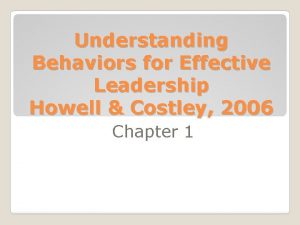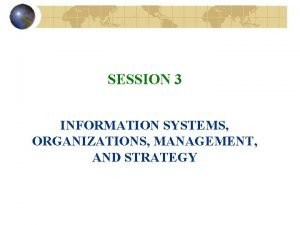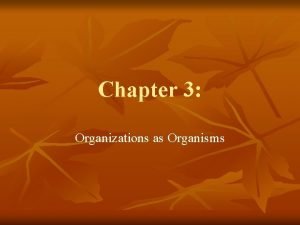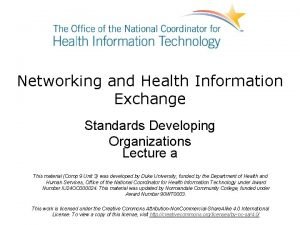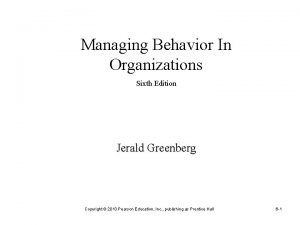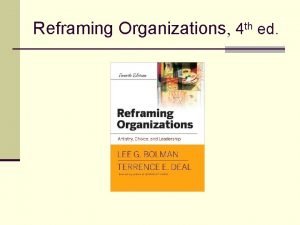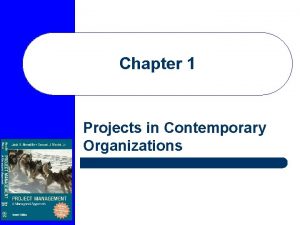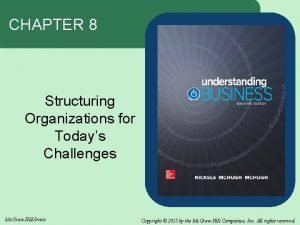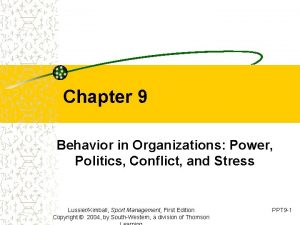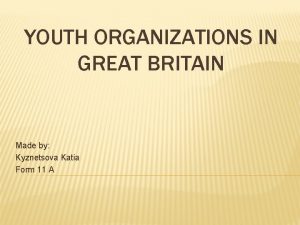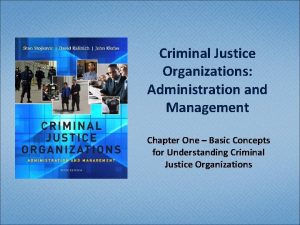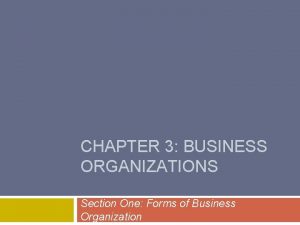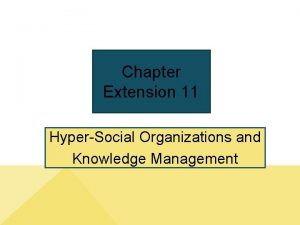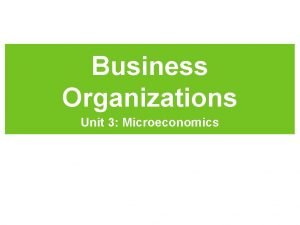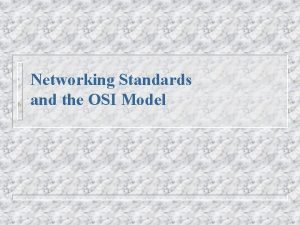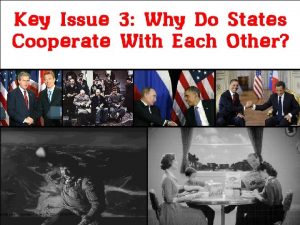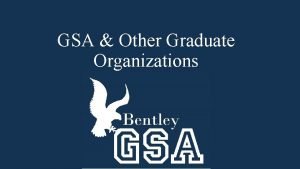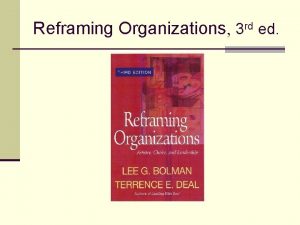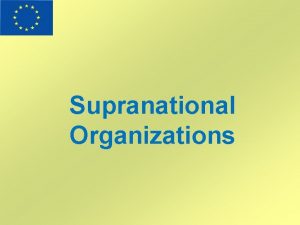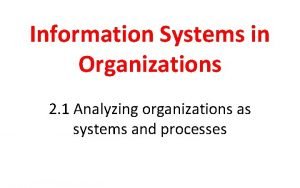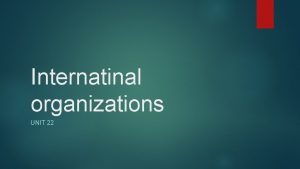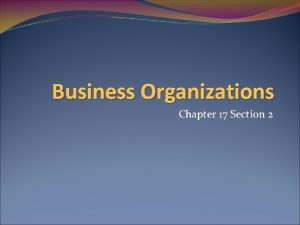Leadership in Organizations 9 1 Understanding Leadership Leadership





















- Slides: 21

Leadership in Organizations 9– 1

Understanding Leadership • Leadership defined… The ability an individual demonstrates to influence others to act in a particular way through direction, encouragement, sensitivity, consideration and support. 9– 2

Supervisors Versus Leaders “Not all leaders are supervisors, nor are all supervisors leaders. ” • Supervisors Ø Persons whose influence on others is limited to the appointed authority of their positions to reward and punish. • Leaders Ø Persons with managerial and personal power who can influence others to perform actions beyond those that could be dictated by those persons’ formal (position) authority alone. 9– 3

Trait Theories Of Leadership • Trait theories of leadership Ø Theories that attempt to isolate characteristics that differentiate leaders from nonleaders v Attempts to identify traits that always differentiate leaders from followers and effective leaders from ineffective leaders have failed. v Attempts to identify traits consistently associated with leadership have been more successful. 9– 4

Six Traits That Differentiate Leaders from Nonleaders 9– 5

Charismatic Leadership • Charismatic leader defined… Ø An individual with a compelling vision or sense of purpose, an ability to communicate that vision in clear terms that followers can understand, a demonstrated consistency and focus in pursuit of the vision, and an understanding of his or her own strengths. 9– 6

Charismatic Leadership • A charismatic leader influences followers by: Ø Stating a vision that provides a sense of community by linking the present with a better future. Ø Communicating high expectations and expressing confidence that followers can attain them. Ø Conveying, through words and actions, a new set of values, and by his or her behavior setting an example for followers to imitate. Ø Making self-sacrifices and engaging in unconventional behavior to demonstrate courage and convictions about the vision. 9– 7

Key Characteristics of Charismatic Leaders • Idealized goal • Ability to help others understand the goal • Strong convictions about the goal • Behavior that is unconventional • Assertive and self-confident • High self-monitoring • Appearance as a change agent 9– 8

Visionary Leadership “A vision should create enthusiasm, bringing energy and commitment to the organization. ” Ø The key properties of a vision are inspirational possibilities that are value centered, realizable, and have superior imagery and articulation. • Visionary leadership Ø The ability to create and articulate a realistic, credible, attractive vision of the future that grows out of and improves upon the present 9– 9

Skills of Visionary Leaders • The ability to explain the vision to others. Ø Make the vision clear in terms of required actions and aims through clear oral and written communication. v (Ronald Reagan – return to happier & prosperous times) • The ability to express the vision not just verbally but through the leader’s behavior. Ø Behaving in ways that continually convey and reinforce the vision. v (Herb Keller – SW Airlines) • The ability to extend the vision to different leadership contexts. Ø Sequencing activities so the vision can be applied in a variety of situations 9– 10

How to Become a Leader • Development of the following skills: ØTechnical skills (ability to assist others) v Tools, procedures, and techniques that are unique to your specialized situation ØConceptual skills (anticipate the future) v Ability to think in the abstract, analyze info, and make connections between the data ØNetworking skills v Socialize and interact with outsiders ØHuman relation skills v Work (people skills) with, understand, and motivate other around you 9– 11

The Ohio State Studies • Studies that sought to identify independent dimensions of leader behavior Ø Task-centered leader Ø People-centered leader 9– 12

Ohio Studies- Task-centered leadership • Task-centered leadership defined… Ø An individual with a strong tendency to emphasize the technical or task aspects of a job v Ensures compliance with rules, regulations, and production goals • Example: Ø Autocratic Leader (taskmaster) v Leaves no doubt as to who’s in charge, and who has the authority and power in the group 9– 13

Ohio Studies- People-Centered • People-centered leader defined… Ø Emphasizes interpersonal relations with those he or she leads. (preferred by today’s workforce) v Takes personal interest in needs of his/her employees • Example: Ø Participative leadership style v Leadership style of an individual that seeks input from followers for many of the activities in the organization v Perspective #1: Consultative-participative leadership – Obtain input, but makes final decision v Perspective #2: Democratic-participative leadership – Obtain input and decision is made by the group 9– 14

Situational Leadership • Situational leadership theory (Hersey & Blanchard) Ø Leaders should adjust (high-self monitors) their leadership styles—telling, selling, participating, and delegating—in accordance with the readiness of their followers. Ø New leadership model and getting much attention. v Acceptance: Leader effectiveness reflects the reality that it is the followers who accept or reject the leader. v Readiness: a follower’s ability and willingness to perform. v At higher levels of readiness, leaders respond by reducing control over and involvement with employees. 9– 15

Situational Leadership 9– 16

Hersey and Blanchard’s Situational Leadership® Model Exhibit 11. 7 Source: Reprinted with permission from the Center for Leadership Studies. Situational Leadership® is a registered trademark of the Center for Leadership Studies, Escondido, California. All rights reserved. 9– 17

Situational Leadership • R 1 (Telling) Ø Employee does not know how to do a job function • R 2 (Selling) Ø Employee questions why certain things have to be done a certain way • R 3 (Participative Leadership) Ø Employee has become the expert on the job and no longer needs to be told what to do • R 4 (Delegating) Ø Employee has gained trust and needs to be left alone. Assign tasks and let him/her do the taks 9– 18

Credibility & Trust • Credibility Ø Employees judge credibility in terms of: v Honesty v Competence v Ability to inspire • Trust Ø The belief in the integrity, character, and ability of a leader 9– 19

Five Dimensions of Trust • Integrity Ø Honesty and truthfulness • Competence Ø Technical and interpersonal knowledge and skills • Consistency Ø Reliability, predictability, and good judgment • Loyalty Ø Willingness to protect and save face for a person • Openness Ø Willingness to share ideas and information freely 9– 20

The Challenge of Team Leadership • Becoming an effective team leader requires: Ø Learning to share information. Ø Developing the ability to trust others. Ø Learning to give up authority. Ø Knowing when to leave their teams alone and when to intercede. • New roles that team leaders take on Ø Managing the team’s external boundary Ø Facilitating the team process ØThe end 9– 21
 Understanding behaviors for effective leadership
Understanding behaviors for effective leadership Universal international organizations
Universal international organizations Information systems organizations and strategy
Information systems organizations and strategy Organizations as organisms
Organizations as organisms Standards development organizations in healthcare
Standards development organizations in healthcare Managing behavior in organizations 6th edition
Managing behavior in organizations 6th edition Reframing organizations (doc or html) file
Reframing organizations (doc or html) file Projects in contemporary organizations
Projects in contemporary organizations Decision making conditions
Decision making conditions International child welfare agencies
International child welfare agencies Structuring organizations for today's challenges
Structuring organizations for today's challenges Power politics and conflict in organizations
Power politics and conflict in organizations Designing organization for international environment
Designing organization for international environment Youth organizations in great britain
Youth organizations in great britain Management in criminal justice organizations
Management in criminal justice organizations Chapter 3 business organizations
Chapter 3 business organizations International union of forest research organizations
International union of forest research organizations Young canada works in heritage organizations
Young canada works in heritage organizations Hyper social organization
Hyper social organization Types of organizations
Types of organizations How big are dental service organizations
How big are dental service organizations Network communication models
Network communication models
